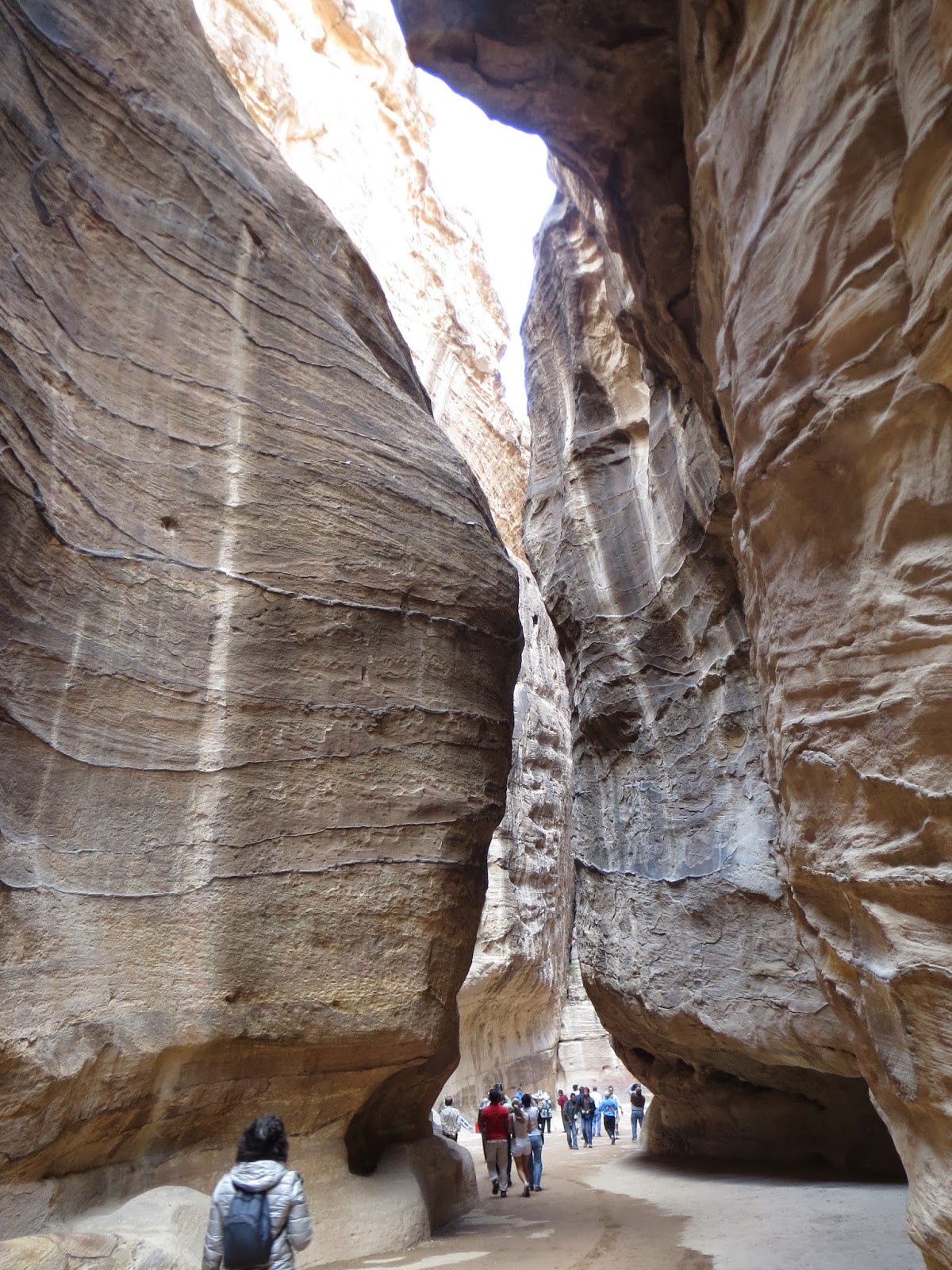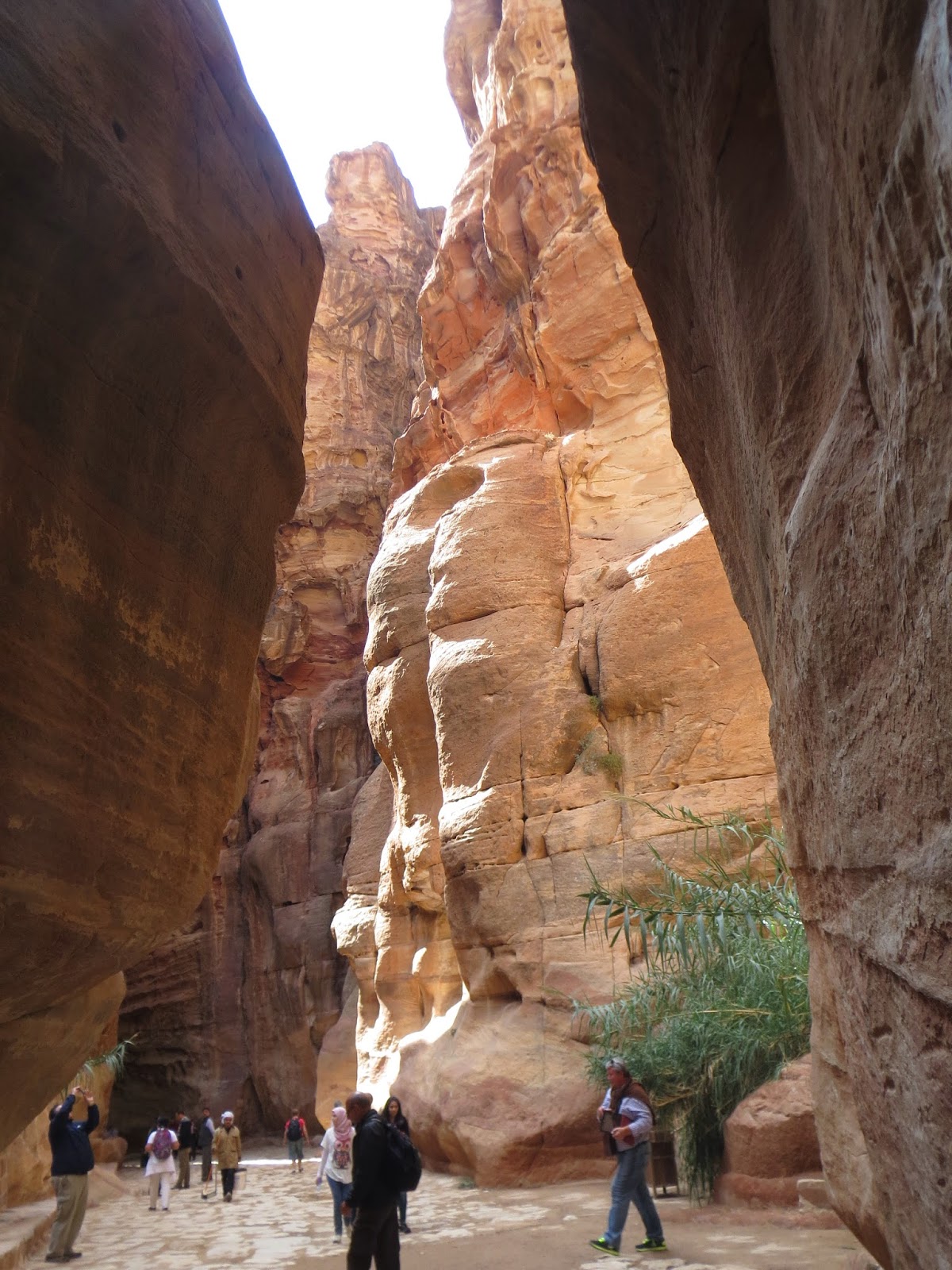Sasipin, a Thai woman, and her Japanese husband, Hiroshi,
whom Steven had met over dinner the night before, generously offered us a ride
in their rental car from Wadi Rum up to Petra. We had planned to take the local bus so being driven
in a car was a delightful treat indeed. The four of us were driven in the open
truck back to Wadi Rum from the Bedouin Lifestyle camp before we left about 8:30 for the 2 hour drive north to Petra. Hiroshi works for a company in Tokyo that owns Sprint so he come to Overland Park, Kansas pretty frequently on company business, he mentioned.
Sasipin told us that she flies back to Bangkok at least once a year to visit her parents as she’s an
only child. She and Hiroshi have been married for 17 years and met in Thailand, she explained. They came to Jordan for a whirlwind 10 day visit and thus were only able
to spend a few hours camel riding and seeing a few sights in Wadi Rum; they
likewise only had the rest of the day to take in Petra’s sights. Hiroshi dropped us off right in front of
our hotel which was aptly called the Rocky Mountain Hotel!
 |
The lovely Sasipin, originally from Bangkok.
|
 |
The thoughtful Hiroshi from Tokyo
|
 |
With Hiroshi, Sasipin and
Attallah, the owner of Bedouin Lifestyle Tours in his office in Wadi Rum.
|
 |
Loved this sign on the road
to Petra!
|
We had come to see Petra
Archeological Park which is actually right next to the small town of Wadi Musa located in the center of Jordan. Petra
has been a UNESCO World Heritage Site since 1985 and in 2007 it was voted one
of the New Seven Wonders of the World. The ancient city of Petra (which is the Greek word for ‘rock’) was the capital
of the Nabatean Kingdom. The Nabateans, a nomadic Arab tribe that moved
across the deserts of the Arabian
Peninsula, were experts at
conserving water in the barren Arabian deserts; they engineered water systems
that collected, transported and stored ample water for the city’s population
and its visitors as well as for livestock and irrigation. Rainwater was
collected via open cisterns and reservoirs and then channeled to all parts of
the city for daily use.
The Nabateans were traders
long before the rise of their kingdom as trade was part of their nomadic
lifestyle. Incense was one of the main items traded by the Nabateans as it was
in high demand. The people also had several industries that supplied their
basic needs and produced items for export. They extracted bitumen and salt from
the Dead Sea, which was used in Egypt for mummification. They produced balsam and mined
copper and iron, produced perfumes using plant oils and frankincense, grew
grapes and used pottery to make bowls, plates, jugs as well as clay pipes to
transport water. What an incredibly civilized society.
We were again so fortunate being
able to check into the hotel mid morning even though the official check in time
was hours later. We dumped our stuff and paid the flat rate for taxi fares
around town of 3JD ($4.20) to take us to the Visitors’ Center. Certainly a
different experience there as we had to queue for quite a while, then show our
passports and pay the hefty fee of 55JD each, about $77, for a 2 day
personalized ticket.
 |
Djinn Blocks
|
Once done with the
formalities, we walked more than 3km along the main path through Petra’s central valley downhill on stony ground through a
massive canyon. It was great walking down even though we realized there was a
drop in altitude from 1027m at the entrance to 861m at Petra’s city center; that’s equivalent to a 40 story
skyscraper and meant we had tired thighs to look forward to on the way back up!
Some people opted not to walk but take a carriage or horseback ride instead.
 |
| Obelisk Tomb |
 |
Walking through
the Siq Canyon hemmed in by cliffs soaring up to 80m high with often
small groups of people ahead and behind us was thrilling but we did need to
have our wits about us and listen for the clickety clack of carriage wheels as
they roared past us through the canyon.
|
 |
Photos of the canyon above and below.
|
 |
| Bizarre looking geological formations, colorful
rocks, water channels cut into the cliffs and votive niches carved into the
rock all greeted us on our canyon stroll. |
 |
| Just when we thought we had seen enough dazzling
sights in the Siq, emerging from it we suddenly came face to face with the awe
inspiring Al-Khazneh, known in English as the Treasury. It’s the pride
and joy of Petra and the most beautiful monument there. It was carved in the 1st
C B.C. as a tomb of an important Nabatean king but possibly later used as a
temple. |
 |
It was great fun just sitting
on one of the benches admiring the Treasury's columns and exquisite detailing carved
directly from the cliff face, watching others see it for the first time, being
approached by a number of men offering carriage rides and others hoping we’d
want to go on a camel ride.
|
 |
Past the Treasury and the
adjacent Outer Siq, we came to the Street of Facades, rows of Nabatean
tombs with intricate carvings. The Theater looks Roman but was erected
by the Nabateans in the 1st C. A.D. It’s carved into solid rock
except towards the front on either side where part of it was built
freestanding. Initially it could seat 3,000 people but was later extended to
finally hold about 7,000.
|
 |
| Leaving the Street of Facades, we climbed many flights of steps,
a total of 550 steps, cut into the rock to reach the High Place of Sacrifice,
which was the venue for important religious ceremonies honoring Nabatean
ceremonies.I couldn't resist taking a photo of this donkey who was standing rather precariously on a flat rock face high above all the surrounding ones. Don't know how he got up or would get down. |
 |
Photos from our ascent to
High Place of Sacrifice.
|
 |
Two young girls selling
jewelry and other items to tourists making the climb: the one on the right is Fatima.
|
 |
| Near the top we saw 2 very prominent obelisks,
both over 6m high, that probably represent the chief male and female Nabatean
deities. The extraordinary thing is that they are solid and instead of being
placed there, to leave them sticking up, this entire side of the mountaintop
had to be leveled. |
The spectacular view of Petra from atop the High Place of Sacrifice was our reward for the climb. Rather than simply retracing
our steps, instead we took the steps leading down off the back of the mountain.
The breathtaking views and some of Petra’s most extraordinary rock coloring made the longer
hike worthwhile, not even taking into account the wealth of Nabatean
architecture at every turn.
 |
Can you imagine being on the
back of a donkey and climbing up these incredibly steep steps? I’d be holding
on for dear life with my eyes closed.
|
 |
Can you imagine being on the
back of a donkey and climbing up these incredibly steep steps?
|
 |
Look closely here and you can
see the Lion Monument.
|
 |
This lovely, warmand vibrant woman got me at a weak
moment and I ended up buying several items from her. She was thrilled as was I
which was the perfect combination in my mind.
|
 |
Part of the water collection system the Nabateans were famous for.
|

 |
| The Colored Triclinium above and below. |
 |
| A view of the Roman Soldier's Tomb from the Colored Triclinium. |
 |
The interior of the Roman
Soldier’s Tomb above.
|
 |
I fell in love with the
colors of the rocks, from the rich reds, to the grainy mustard shade and
everything in between.
|
Steven and I didn’t see any
other tourists for quite a stretch of time coming down the back way from the High
Place of Sacrifice. As there was no discernible path either unlike where we’d
been earlier in the day, it got rather hairy for a bit especially as time was
marching on.
 |
A view across the cvalley of the magnificent Royal
Tombs that were carved to house the tombs of Nabatean dignitaries. We had to walk a fair piece to see them in greater detail.
|
 |
The Corinthian Tomb
|
 |
These were some of the stalls
set up to sell items to tourists wanting to view the Royal Tombs. Since it was
getting late, the vendors had gone home for the day.
|
 |
The Palace Tomb was named tha because it had the appearance of a palace!
|
 |
| Returning via the canyon about 4pm. |
 |
A sand design being made; we heard various reports as to how long it takes to learn how to do this well, from as short a time as 6 months to as long as a couple of years.
Once again, another fabulous
day spent hiking among the ruins of a bygone civilization but with camels and
donkeys as our companions.
|









































































































Amazing place. Looks like it was cool, since you were all bumdled up. I think Indiana Jones was at Petra. Polish girl
ReplyDelete